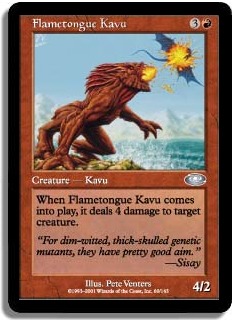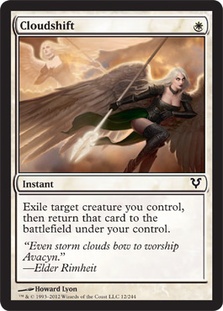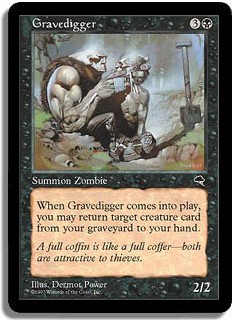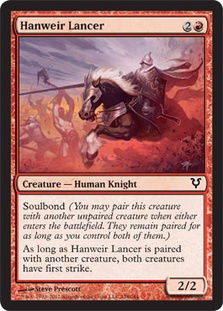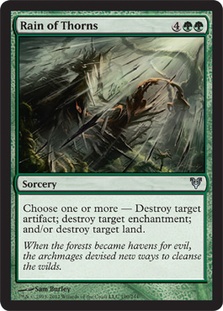A couple of weeks ago, Justin Parnell and I
talked about the cards in Avacyn Restored for Cube
. Though I
only covered, blue, red and miscellaneous cards
, I didn’t talk about how the cards are useful for common and common/uncommon (Pauper and Peasant, respectively) cubes. I wanted to make sure that the
entire cube spectrum was represented, not just “regular” cubes, so I’ll use this article to discuss those cards in the context of Pauper and Peasant cubes.
White
Commons
Cloudshift:
The strange thing about Cloudshift is that it may actually be better in Peasant than in Pauper. If you look at both formats, you’ll notice that the
creatures with “enter the battlefield” triggers are much more prevalent in Peasant than Pauper. To point, some of the best “ETB” creatures at the
respective rarities:
Peasant: Cloudgoat Ranger, Skinrender, Flametongue Kavu
Pauper: Ghitu Slinger, Mulldrifter, Gravedigger (trust me, it’s extremely good!)
Cloudshift has its uses with commons, but going to common to uncommon makes it gain a ton of value. Another advantage for Peasant: Cloudshift returns the
creature to your control, rather than its owner’s, as the only card that really steals things in Pauper is Ray of Command (False Demise isn’t very good)
versus the various Control Magic variants in Peasant cubes (Control Magic, Persuasion, Binding Grasp, etc.) Still, I wouldn’t overestimate that part, as
it’s mostly just gravy.
Righteous Blow:
The best analog for a card like this is Sunlance, a card prized in Pauper since white loses access to Swords to Plowshares and Path to Exile, improving the
stock of cards like Temporal Isolation and Journey to Nowhere. One-mana removal in Pauper white is hard to come by: Sunlance, Kirtar’s Desire, and now
this. It looks quite poor compared to one-mana removal in other colors like Disfigure and Shock (and arguably others like Silent Departure), but
supplementing white’s one-mana removal suite may make it cubeworthy for Pauper, but it probably won’t last for very long. Of course, Peasant cubes have
much better cards so they don’t need to bother with this.
Seraph of Dawn:
This card really stuck out for me for Pauper. Four toughness is huge in the format, as that magical toughness dodges almost all red removal and blocks just
about anything profitably, with most of the four-power creatures being more expensive green beaters or non-flyers, with a few exceptions like Illusionary
Forces and Windrider Eel. While Seraph of Dawn doesn’t offer the insane inevitability of cards like Penumbra Spider, the Seraph’s ability to block nearly
everything in the format while racing decks should put it at staple status.
Competition at Pauper for white 4-drops isn’t as heavy as in regular cubes or even Peasant ones. Finishers aren’t that great in Peasant cubes, but they’re
still better than Seraph in Peasant (which has cards like Serra Angel and Cloudgoat Ranger), which should push this card out of Peasant. In Pauper, though,
where Guardian of the Guildpact stands alone on a mountain of white 4-drops, Seraph of Dawn fits nicely.
Voice of the Provinces:
For the same reasons, Voice of the Provinces should be at home in Pauper cubes (due to the relative lack of powerful finishers) and won’t be at home in
Peasant cubes, although six mana is pricey even for a Pauper finisher. Lately I’ve been pushing higher-cost finishers in my Pauper cube to give control
decks things to ramp into, so Voice of the Provinces fits that strategy well.
Blue
Commons
Alchemist’s Apprentice:
Alchemist’s Apprentice is a riff on cards like Surveilling Sprite, which essentially read “Chump block: Draw a card.” Aside from Sakura-Tribe Elder, cards
like these haven’t made much of an impact in Pauper because players can’t control when they use them, and while Alchemist’s Apprentice lets you control
when you draw, ultimately, it’s just a draw spell attached to a chump block. Not many cubes run Surveilling Sprite; I’d rather run that as an evasive chump
blocker if I had to include, but I’m going with neither.
Crippling Chill:
Solid tempo cards are welcome in Pauper cubes. Cards like Niveous Wisps and Kor Hookmaster help prevent damage or push it through, offering utility on both
offense and defense. The closest analog to Crippling Chill is something like Kor Hookmaster; the Chill is worse due to trading a 2/2 body for a cantrip.
Regardless, in blue Pauper sections that encourage tempo decks with cards like Withdraw, Undo, and Silent Departure, it should be a welcome addition. It’s
also not bad in control builds as a way of keeping problematic attackers down, though Crippling Chill’s natural home remains in tempo. It may be worth a
shot in more tempo-friendly blue sections of Peasant cubes, but it probably won’t make the cut because it doesn’t compare well to other tempo effects in
blue, especially Control Magic variants.
Elgaud Shieldmate:
There isn’t much in the way of self-protection in Pauper: no Sphinx of Jwar Isle, no Frost Titan, no Thrun, the Last Troll. Shimmering Glasskite and
Guardian of the Guildpact are as close as it gets; both cards are prized because most removal is spot removal. (Martyr of Ashes, Bloodfire Dwarf,
Pestilence and Crypt Rats define mass removal in Pauper.) Like the other soulbond creatures, the Shieldmate can be pretty awkward on an empty board but
absolutely backbreaking if it’s protecting something, especially a creature that doesn’t die easily in combat – dealing with a Aethersnipe outside of spot
removal can be hard for decks to pull off. Elgaud Shieldmate may be my favorite card in the set for Pauper cubes and it has a chance to break through to
Peasant cubes because there still aren’t many creatures that protect themselves and as a way to protect finishers like Serra Angel and Artisan of Kozilek.
Keep an eye out for this one!
Ghostly Flicker and Havenguul Skaab:
Ghostly Flicker and Havenguul Skaab look to be suboptimal, but one of my takeaways from drafting the Magic Online cube is using cards as enablers. Both of
these cards will be at their best when they combine with the ETB-triggered creatures in the format, and Havenguul Skaab could be a grad student’s version
of Galepowder Mage. I do remain skeptical on Havenguul Skaab, especially in Peasant, as there are better enablers in the format (foreshadowing!)
Gryff Vanguard:
Gryff Vanguard is obviously no Mulldrifter (what is?) but its base stats of being a 3/2 flier that cantrips for 3UU will be very good for Pauper – it
compares well to Sky-Eel School and Conclave Equenaut and should rule the skies easily. I’ve never been a fan of “easy upgrades,” though, and wouldn’t just
snap-replace Sky-Eel School with Gryff Vanguard as both are solid for the format. Once again, the finishers at Peasant are solid enough that they don’t
need to use Gryff Vanguard.
Mist Raven:
I won’t go into much detail on Mist Raven since the four-mana slot is so ridiculously tight that many won’t have room for Mist Raven, but this card is
going to be extremely good in Pauper cubes. Value creatures are excellent in the format and evasion is hard to come by. I think Mist Raven should even be
good in Peasant cubes, especially those that push tempo, as it complements cards like Riftwing Cloudskate incredibly well.
Uncommons
Nephalia Smuggler:
Nephalia Smuggler is an example of an engine card that could do some work in Peasant cubes. It’s essentially a mono-colored Mistmeadow Witch riff that can
do nasty things with enters-the-battlefield creatures, similarly to Deadeye Navigator but nowhere near as insane. Still, I think that blue blink strategies
will get a big boost in Peasant and cards like Nephalia Smuggler will help push that deck.
Black
Commons
Driver of the Dead:
Gravediggers are staples in the Pauper format with the original, Warren Pilferers, and Cadaver Imp all being great recursive cards, though with relatively
low power. A 3/2 for 3B isn’t knocking down any doors and Driver isn’t so much a Gravedigger as a solid creature that helps give aggressive decks some
reach as a curve topper in decks like R/B aggro. At worst, it attacks for three! The four-mana slot tends to get much more competitive in Peasant, as
uncommon black creatures at that cost generally kill opposing creatures when they enter the battlefield.
Soulcage Fiend:
As Justin Parnell said in his review of white, black and green
, Soulcage Fiend is an incredibly efficient aggressive creature for both Peasant and Pauper decks. Its drawback isn’t that relevant for black aggro decks;
they won’t really care about losing life as much as they care about making the opponent lose 3 life while beating for 3. Soulcage Fiend supplements the
black aggressive suite in both Peasant and Pauper; creatures like Dauthi Marauder, Gatekeeper of Malakir and Skittering Horror all play incredibly well
with Soulcage Fiend. It’ll be not very good versus opposing red decks as it turns the opponent’s Lightning Bolts into Searing Blaze, but isn’t that what
your sideboard is for? Don’t fear the drawback in Soulcage Fiend. It is a very good attacker.
Uncommons
Demonic Taskmaster:
Justin also covered this card
, but I have a sunnier disposition on the card than he does, at least in the context of Peasant cubes. Finishers aren’t anywhere near as good as they are
in “regular” cubes, so using this or Fettergeist as one of the handful of creatures in a deck is definitely serviceable, since it’s an efficient finisher
for the format. Much like how Soulcage Fiend isn’t very good against red, the Taskmaster looks pretty bad against white’s cards like Temporal Isolation and
other white tappers like Whipcorder, but again, it can be sideboarded out in those bad matchups.
Red
Commons
Fervent Cathar:
Goblin Shortcutter is a solid card because it’s a two-mana 2/1 with a decently useful ability in the late game. Falter effects, even if just preventing a
creature from blocking for a turn, are very useful in aggressive and tempo decks (as I discussed before). Fervent Cathar has a relatively small body but
it’ll be solid in aggressive decks as a creature that has value in the late game. It’s no Kor Hookmaster, but honestly, that’s fine in red decks as is.
It’s going to have more competition in Peasant thanks to already existing hasters like Hellspark Elemental. It’ll likely end up on the outside looking in,
but it’s another nice option for those decks.
Hanweir Lancer:
Hanweir Lancer will be at its best in Pauper cubes because many creatures are on the small side. Decks with lots of 2/2s are pretty common in the format
and Hanweir Lancer giving an attacker first strike is handy as it can mess with combat math, especially double blocks. Regardless, the body boost is a bit
small and will likely prevent it from making it into cubes.
Kruin Outlaw:
I really want this card to be good as a Spark Elemental meets Goblin Deathraiders; alas Goblin Deathraiders tends to be on the lower side of BR Pauper cube
slots, but that’s mainly because there are so many good BR cards (especially if you’re counting things like Strangling Soot). Even as a guy that attacks
once and crashes into a 2/2, the Outlaw is still a solid creature that gets damage in there (and besides, isn’t that what most Pauper and Peasant red decks
want to do)? The competition gets tighter in Peasant with cards like Hellspark Elemental, Lightning Mauler, and Blood Knight, so it may be relegated to
“filler” status (to where you can run it if you want some more support for red aggressive strategies). It won’t be insane in Peasant, but I’ll be happy to
put it in my Pauper cube.
Pillar of Flame:
Although there are various graveyard shenanigans in both formats, like the Gravediggers of the format, the upside of exiling a creature is definitely
outweighed by the sorcery speed drawback, as many cubes of either Pauper and Peasant varieties don’t use Shock either.
Stonewright:
I initially missed Stonewright in my evaluation and mainly thought about it because Evan Erwin included the card in his recent cube update. Soulbond creatures
are essentially equipment strapped onto bodies, much like Living Weapon, and Firebreathing has never been this cheap. It’s a card I’m experimenting with in
my regular cube but it’s been solid as a way to just pump offensive creatures, especially evasive ones. A 1/1 for R can be awkward if it has nothing to
pair with, but it works very well with small guys that want to just jam damage as much as possible.
Uncommons
Thunderous Wrath:
I really want for this card to be good and it might be possible to make a deck that effectively uses miracle, but the critical mass isn’t there in the
format and the “base mode” of five damage for six mana just isn’t enough for the format.
Green
Commons
Abundant Growth:
Since there isn’t much land destruction in Pauper (and only slightly more in Peasant), Abundant Growth is essentially green’s version of Prophetic Prism, a
card that’s not bad as filler in Pauper cubes. There has been a movement to push green ramp and fixing in cubes, and Abundant Growth certainly fits that
mold as helping to encourage green tri-color color decks alongside Cultivate and Harrow. Abundant Growth is worth considering if you’re wanting to push
green as “the fixing” color; while I want green to be good at fixing and ramp, I’m skeptical on whether this card is worth the slot in a Pauper cube. It
may very well be.
Wildwood Geist:
Wildwood Geist is another variant on the many 4G common creatures in Pauper cube, hitting the same slot Okina Nightwatch, Barkhide Mauler and Stampeding
Rhino. Its closest analog, however, is Territorial Baloth. The consistency of always being a 5/5 when you attack is very good, but typically I’ve found
that when I’ve used it, the green ramp decks that ran it didn’t have a problem with landfall. Wildwood Geist also isn’t a very good blocker – normally with
aggressive creatures, that isn’t a very relevant drawback, but it is a very relevant thing for midrange and control decks, making it worse than Territorial
Baloth and other 4G/3GG common beaters.
Uncommons
Rain of Thorns:
The main problem with Rain of Thorns is that it just costs way too much for the effect, especially in Peasant. I nicknamed Rain of Thorns as “Into the Mold
of Hell” because it usually kills an artifact and a land, much like how Into the Maw of Hell destroyed a creature and a land in Innistrad Limited, and the
best-case scenario of destroying three permanents or the versatility mattering won’t happen that much. Cards like Creeping Mold, Acidic Slime and even
Brutalizer Exarch are much better answers to opposing artifacts and enchantments.
Triumph of Ferocity:
This was another card that I overlooked at first, but it’s the closest thing to Phyrexian Arena that the Peasant format has. Decks like green-based ramp
won’t have a hard time triggering the draw on Triumph of Ferocity, and as many writers have pointed out, even having something like a Wall of Roots or an
Arbor Elf on an otherwise empty board will draw a card, so most ramp decks will be able to get a few cards from it. The main question is how many cards
it’ll draw on average in a game — if it’ll end up drawing more cards than something like Harmonize or even Krosan Tusker — and that is difficult to say.
Triumph may end up being a card that is too inconsistent for any cube as it’s a poor topdeck and may have an overall weaker effect than a similarly costed
draw effect. Much like Elgaud Shieldmate in Peasant cubes, though, it’s something that’s something to keep an eye on!
Artifacts
Uncommons
Angel’s Tomb:
Like Kruin Striker, I really want this card to be good as a 3/3 flier for three mana, but unfortunately and unlike the Striker, it’s reliant on having
creatures come into play to attack. As we’ve learned through creatures like Mogg Conscripts and Goblin Cohort, although the optimal start for aggressive
decks is curving into creatures to help power these creatures out, it doesn’t always happen. An upside of it not being a creature during the opponent’s
turn is that it gets around sorcery speed removal, but there isn’t much sorcery-speed mass-removal in Pauper and Peasant aside from the “red wraths” in
Peasant like Breath of Darigaaz, Sulfurous Blast, and Whipflare. In that way, it emulates the underrated Chimeric Idol, but the strength of that card was
being extremely good after mass removal. Angel’s Tomb just isn’t.
Vessel of Endless Rest:
Finally, the Vessel is an interesting option for Peasant cubes; I’ve never been a fan of narrow graveyard hosers that have no value against so many decks,
but the Vessel is color-fixing with incidental graveyard hate. It’s worth considering if your Peasant cube de-emphasizes color-fixing as part of green’s
identity.
Wrapping Up
You may have noticed that the last section was pretty short, but unfortunately, a lot of the artifacts don’t really do very much for the format, with most
being suboptimal tribal support (Scroll of Avacyn and Scroll of Griselbrand), overcosted equipment (Tormentor’s Trident), or suboptimal artifact creatures
(Narstad Scrapper and Haunted Guardian). Granted, artifact sections in Peasant are pretty tight already and while Pauper artifact sections got a huge boost
from Scars of Mirrodin block, there haven’t been a ton of good artifacts for the format since. But hey, the rest of the sections for Pauper and Peasant
cubes look like they got some nice tools to use!
I hope that you’ve enjoyed this look at Avacyn Restored for cube and that it’s given you some options for your pauper and peasant cubes.
May all of your opening packs contain Sol Rings!
@UsmanTheRad
on Twitter
My blog featuring my cube lists: http://idratherbecubing.wordpress.com – including Avacyn Restored changes to my cube!
Cube podcast that I and Anthony Avitollo co-host: The Third Power

